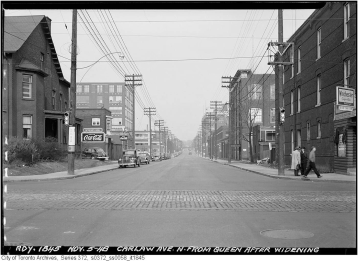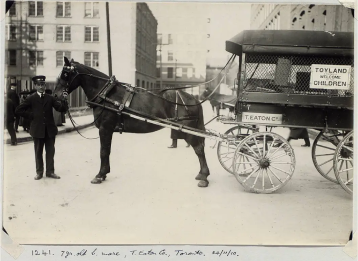


In the 1830’s, workers paved Queen Street east with planks. It became a toll road. Stage coaches and travelers had to stop at a toll booth, where the Duke of York is now. Like service centres on today’s expressways, entrepreneurs came to serve travelers who needed to water and feed their horses in stables and replace lost horse shoes in the blacksmith shops. Wayfarers also rested, fed and watered themselves.
By 1852, the village boasted three hotels, a blacksmith shop, and several general stores. When George Leslie, owner of Canada’s largest tree nursery, took over the Post Office and general store, Leslieville was born.
As Toronto’s population exploded in the 1850s, farmers subdivided their fields into small lots. Here market gardeners grew fruit and vegetables to feed the city.
Meanwhile others found clay deposits and turned out bricks to build Toronto. Drovers herded cattle, sheep and hogs along the road from the surrounding countryside.
After they reached the tollgate, they turned their weary, hungry animals loose on the grass along Ashbridges Bay to fatten and Leslieville’s butchers supplied steaks, chops, sausages, bacon, etc. to feed “Hogtown”.
Abattoirs, nurseries, and brickyards became Leslieville’s major employers. Others cut ice and fished on Ashbridge’s Bay. Small shops provided necessities from sewing needles to shoes. Soon professionals such as doctors and pharmacists came to care for the body and clergymen to care for the soul. And so Leslieville grew until in 1884 it became part of the City of Toronto and large industries began to locate in the East.



Written By: Joanne Doucette, local historian, Leslieville Historical Society

For more information on how to register your business, volunteer with the BIA or any other questions, please email us at [email protected]
We acknowledge that what we now call Toronto is on the traditional territory of many nations including the Mississaugas of the Credit, the Anishnabeg, the Chippewa, the Haudenosaunee and the Wendat peoples and is now home to many diverse First Nations, Inuit and Métis peoples. We also acknowledge that Toronto is covered by Treaty 13 signed with the Mississaugas of the Credit, and the Williams Treaties signed with multiple Mississaugas and Chippewa bands.